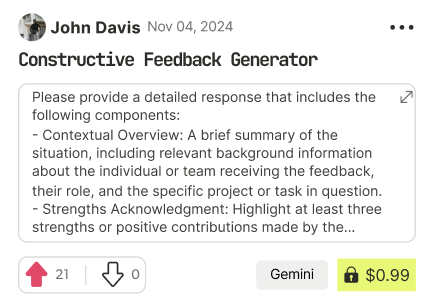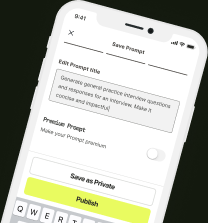prompt mine App
Find, Create & Share AI Magic
Reconnecting Your Designer's Spark: Navigating AI Anxiety
Hello. Take a deep breath. It's completely understandable to feel a mix of anxiety and creative block when facing the rapid advancements of AI, especially as a designer concerned about the fear of AI replacing your job. These feelings are valid, but they don't have to define your creative journey. Think of this moment not as a threat, but as an invitation to explore a new landscape of possibility.
My purpose is to help you gently reconnect with your passion, using these new tools not as adversaries, but as unique collaborators to spark joy and reduce stress. Here is a personalized, actionable plan designed to help you navigate this space and rediscover your creative flow:
1. Embrace Playful Exploration, Not Pressure: Set aside the pressure of client work or portfolio pieces for a while. Instead, approach AI tools with a sense of playful curiosity, much like you might doodle in a sketchbook. Use AI image generators like Midjourney, DALL-E, or Stable Diffusion to create things completely unrelated to your usual design tasks. Generate abstract patterns based on emotions, visualize fantastical creatures, or simply see what happens when you type in random words. This low-stakes experimentation helps you see AI as a creative playground and curiosity-driver, not just a job tool, reducing the anxiety associated with its professional implications. It’s about finding the fun again.
2. Leverage AI for Tedious Tasks & Rapid Ideation: Identify aspects of your design process that feel repetitive or are prone to causing block (e.g., generating countless variations, finding the perfect stock image alternative, creating mockups quickly). Use AI-powered design features or dedicated tools to handle these. For instance, explore Adobe Firefly integrated into Photoshop or Illustrator for quick variations, content-aware fill enhancements, or generating texture ideas. Use Canva's Magic Design or similar features to quickly generate initial layout ideas or assets. By offloading the more mechanical or time-consuming steps to AI, you free up your valuable mental energy and creative capacity for the higher-level conceptual thinking, refinement, and unique artistic decisions that only you can make.
3. Integrate & Elevate with Your Human Touch: View AI outputs as raw materials or sparks, not final products. The real magic happens when you take an AI-generated element – a texture, a concept image, a rough layout – and integrate it into your existing design workflow, applying your learned skills, aesthetic judgment, and personal style. Combine AI-generated visuals with your hand-drawn typography, refine colors and composition with your expert eye in Photoshop or Illustrator, or use AI concepts as jumping-off points for complex layouts in Figma. This step emphasizes the unique value you bring as a designer: the ability to curate, refine, combine, and imbue work with meaning and emotion in a way AI currently cannot replicate. It transforms potential replacement into powerful enhancement.
Remember, your creativity is resilient. AI is a new tool in the vast toolbox of human expression. By approaching it with curiosity, using it to reduce friction, and focusing on how you can transform its outputs with your unique skills and vision, you can not only overcome this block but also discover exciting new ways to create and thrive as a designer. Be kind to yourself during this process, celebrate small explorations, and trust in your inherent creative power. You've got this.

Find Powerful AI Prompts
Discover, create, and customize prompts with different models, from ChatGPT to Gemini in seconds

Simple Yet Powerful
Start with an idea and use expert prompts to bring your vision to life!

